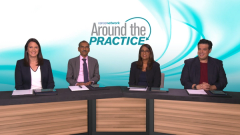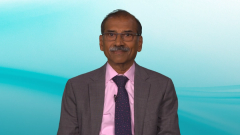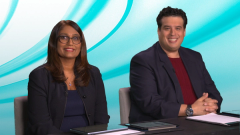
Induction Regimens in Transplant-Eligible NDMM: Clinical Trial Data
Comprehensive insight on mainstay induction therapy options for patients with transplant-eligible newly diagnosed multiple myeloma in the context of recent clinical studies.
Episodes in this series

Transcript:
Sundar Jagannath, MD: There was a recent publication of the DETERMINATION study by Paul Richardson [MD, Dana-Farber Cancer Institute, Boston, MA] in the New England Journal of Medicine. This was a large study of randomization between VRd [bortezomib (Velcade), lenalidomide (Revlimid), and dexamethasone] vs VRd plus transplantation. What are the take-home messages of the DETERMINATION study?
Shambavi Richard, MD: The DETERMINATION study was presented by Paul Richardson at ASCO [American Society of Clinical Oncology] this year. It is also now in publication, in the New England Journal of Medicine. This was a transplant vs non-transplant approach for the triplet induction of VRd. Patients who were on the transplant arm had 3 cycles of VRd and went on to stem cell harvest, and the transplant was followed by 2 cycles of VRd consolidation and went on to lenalidomide maintenance. Patients in the non-transplant arm had the 3 cycles of VRd. They had the harvest and then went back on VRd treatment and they received 5 cycles of that consolidation. Then, [they] went on to Revlimid maintenance. All patients received maintenance indefinitely until either progression or intolerance of the treatment. The study’s analysis was updated and at the median follow-up of 76 months, they had a median progression-free survival of 67.6 months for the transplant arm as opposed to 46.2 months for the non-transplant arm. This translated to a hazard ratio of 0.45. The response rates were also considerably better for the transplant arm. MRD [minimal residual disease]-negative was seen in 52% of the transplant arm vs 37% for the non-transplant arm. The overall survival, however, was not any different. On both arms, the median overall survival was at about 5 years and was around 80%. This gave us good insight into the power of continuing Revlimid maintenance to progression. This actually compares very nicely [with the] IFM 2009 trial. In that study, the design was the same except they received Revlimid maintenance for just a year. And in that case, the median progression-free survival was about 47 months for the transplanted arm vs about 35 months for the non-transplant arm. So you can see that with the continued Revlimid to progression, the progression-free survival was significantly different. Neither of these studies showed a difference in overall survival.
Sundar Jagannath, MD: In general, we see that when you give maintenance therapy and you continue the maintenance therapy vs another arm, if you stop the maintenance therapy at a certain fixed time, there’s always a chance for increased relapse in the arm where you discontinued maintenance therapy. Whether it was daratumumab [Darzalex] that has been studied with that. Kd plus dara [carfilzomib (Kyprolis) and dexamethasone plus daratumumab] vs Kd [carfilzomib and dexamethasone] alone where the dara [daratumumab] maintenance continues they would do better. Likewise, with the Revlimid. I do understand continuous Revlimid, but the French people stop because of the signal of second malignancy. That’s why they had a restriction for 2 years and then they discontinued it. But in this particular study, I wanted to ask you, they use Revlimid 10 milligram [mg] continuously without a break. But in my practice, I would use it for 21 days with a 1-week break. Do you have anything to say about that?
Shambavi Richard, MD: I do find that the tolerance for the Revlimid is a little better when they get the week’s break. Of course, these have not been ever studied head-to-head and many of the trials have used continuous maintenance. But I certainly agree with you that I’ve in general tended to use the 3 weeks on and 1 week off and the patients have been able to stay on it for significant amounts of time.
Sundar Jagannath, MD: Now, Dr Rossi, we know that in the introduction I said you can use a 3-drug combination or you can use a 4-drug combination now that we have daratumumab to the combination of Velcade, Revlimid, and dexamethasone. So we heard the DETERMINATION results with the VRd. Could you enlighten us about the results of the GRIFFIN study where they used daratumumab with VRd?
Adriana Rossi, MD: Absolutely. So with GRIFFIN, they use the backbone. I would say bortezomib, lenalidomide, dexamethasone induction followed by transplant with consolidation and maintenance lenalidomide. And added dara [daratumumab] through all of the stages. And so the comparator arm was dara [daratumumab]-VRd induction with the transplanted dara [daratumumab]-VRd consolidation and then dara [daratumumab] in the maintenance setting as well. It was very encouraging, I think, to have the more mature data where we see that the response rates do continue to deepen with time and continue to separate. So not only the overall responses but with MRD data I think the most exciting update for it would be the MRD status over time. And so as we move from attaining an MRD-negative status to sustained MRD negativity, we see that those patients who are able to sustain their MRD-negative status for 6 months seem to all have retained it through 12 months. And that’s a very encouraging argument in favor of continuing the daratumumab through all of these different phases. Both induction, consolidation, and again through maintenance.
Sundar Jagannath, MD: It’s interesting, you talked about the minimal residual disease, or MRD. There are a couple of ways of determining MRD by multiparametric flow cytometry or by using next-generation sequencing through the adaptive technology called Connex.And we generally believe that the molecular determination is better than -6 10as compared to multiparametric flow cytometry. It’s only up to -510. So there is a 1-log difference there. But are we tailoring treatment to MRD as the goal? And in this regard, there was a MASTER trial done. Josh, do you want to give us an idea, about what the MASTER trial was? And do you really believe in the MRD-defined treatment goal?
Joshua Richter, MD: The MASTER trial was a really interesting trial with the data recently presented by Luciano Costa MD [The Kirklin Clinic of UAB Hospital, Birmingham, AL]. In the MASTER trial, they gave the quadruplet as opposed to the dara [daratumumab]-RVd that many of us are giving. They gave dara [daratumumab]-KRd [carfilzomib (Kyprolis), lenalidomide (Revlimid), and dexamethasone] and substituted Kyprolis for the bortezomib. Patients received 4 induction cycles and then went on to autologous stem cell transplant. Followed by post-transplant consolidation with more dara [daratumumab]-KRd followed by lenalidomide maintenance. But what they had built in was exactly what you alluded to, at various time points they assessed for MRD status. And patients who were able to maintain their MRD negativity were able to stop therapy. Ultimately, when we broke down the groups into 3 categories, patients with no high-risk cytogenetic abnormalities, 1 high-risk cytogenetic abnormality, or 2 or more. We saw some interesting patterns. One was that all groups seem to improve their response over time exactly as Dr Rossi talked about. The 2 or more high-risk cytogenetics didn’t get those same levels of MRD negativity. But more importantly, over time those patients that were observed off of therapy after a period of time, the 0 and 1 high-risk cytogenetic abnormality patients, many of them continue in remission. But those that had 2 or more high-risk cytogenetic abnormalities that were stopped, even if they achieve MRD negativity, are relapsing at a much higher rate. So I think that MRD negativity is an important factor that we need to use but we need to go a step further and say, “Well, what [does] the underlying disease look like?”
Sundar Jagannath, MD: I think in this regard obtaining MRD negativity at one point should not be the end goal. I think that is the most important message I take out of that. Sustained MRD negativity is important and the sustained MRD negativity should be multiple years, not 1 year apart 2 times. They should be MRD-negative at years 3, 4, and 5. Then I would say you accomplished your goal and potentially cured the patient. So MRD negativity just to achieve it is not enough. You also have to sustain it over a period of time. So that’s important.
Transcript edited for clarity.
Newsletter
Stay up to date on recent advances in the multidisciplinary approach to cancer.






















































































